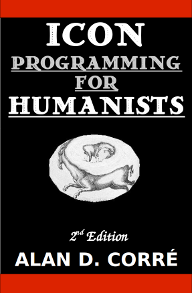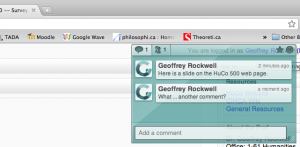I’m at the Montréal International Games Summit 2010 (MIGS) for today and tomorrow. My conference notes are at Philosophi.ca – MIGS conference report.
Crowdsourcing Knowledge
Today we held an event at the University of Alberta around developing a new form of collaboration. Peter Robison from the University of Saskatchewan organized the day’s discussion and we had participants from across the country, though most were from the medieval editing community in Western Canada.
Peter started us off by arguing that we need intelligent documents and the way he is doing that is working with RDF. He believes “the interface is the enemy” of researchers trying to study across documents. He believes that XML/TEI isn’t enough; we need intelligent documents that carry assertions that can help other users of the data. I’m intrigued by this idea of “assertions” and I know Allen Renear has been working on what can be said about a document.
Dan O’Donnell argued that we should think about interchange rather than interoperability. He pointed out that most people want access to the data of others to do their own analysis and repurpose for their own. Brent Nelson talked about his Digital Donne project and bringing traditional researchers into digital projects. He then talked about his cabinet of curiosities project. Allison Muiri talked about her Grub Street project and legal issues around involving a larger community.
One issue that we went back and forth on was the place of interface. I’m convinced that the idea of the separation of form and content is just one assertion among many. In some situations it makes sense to talk about separating interface, in others it doesn’t.
One thing we are all struggling with is essentially the human processes. Computers are really not the issue, what we need is support for changing the research culture:
– How do you get participation?
– How do you encourage openness to interchange?
– What will our universities allow us to do?
– How will we get credit for what we are doing?
– How can we run production services or who can run them for us?
Yin Liu talked about how we are here because we have failed. This was in response to Peter’s claim that we were here because we had all succeeded. Yin also said that she would like to no longer list herself as a digital humanist but as a medievalist. The time may come when we are all digital humanists – that, of course, is the culture change we are interested in.
Meagan Timney talked about linking – linking of people, linking of digital humanities to traditional disciplines, linking to training of undergraduates. Dean Irvine talked about how to pitch editing outside of the humanities. Training became a keyword – editing is a way to train students in informatics.
We ended by brainstorming about a partnership that could bring together many of the players in Canada while providing an inclusive culture for new scholars. What could a new type of organization look like?
UK: Graduate employment not where you expected
The Guardian has a story about (university) graduate employment and unemployment, Graduate unemployment at highest level for 17 years (Jessica Shepherd, The Guardian, November 1, 2010). What interested me was the statistics about how different types of degrees fared.
Those who had studied Chinese had the highest starting salary at £24,540 a year, while fine art graduates started on the lowest wage at £14,625. …
The government describes engineering degrees as “strategically important” for the economy. But 11.9% of civil engineering graduates were out of work six months after they graduated, as were 11.8% of mechanical engineering graduates. Geography and psychology graduates were least likely to be unemployed. Some 7.4% and 8.3% were out of a job respectively.
The author is well aware of the irony that the statistics don’t support the British government’s assumptions about which programs are valuable and therefore worthy of funding support. Arts and humanities are likely to see deep cuts. As for informatics, the article reports that,
Graduates with degrees in IT fared worst. One in six – or 16.3% – were unemployed six months after graduation. The previous year, 13.7% were out of work after the same period.
So you Want to Get a PhD in the Humanities
Thanks to Colette I came across a pointed xtranormal animation titled, So you Want to Get a PhD in the Humanities. The animation is of a dialogue between a student who wants a letter of reference to graduate school and a burnt out prof. The students is idealistic and insists on going for a PhD in order to be a college professor. The professor is trying to dissuade her. The dialogue seems well written, though the automatic voices sometimes miss the timing needed to get the barbs.
Nigerian scam,Scam checker tool,419 scam ,scam baiting,scammers database,scam,avoid scam mail tips and awareness
I just found an interesting site about Nigerian scams. The site has some history, it has a bibliography of books on the subject, it has an archive of example emails, and it tracks people who seem to be fraud artists. While the site at times seems to have an amateur side it has a lot of information.
I must admit that I’m interested in this as I’ve begun to think of spam as a form of creative writing. Spammers have to tell a story that will entice people to start up a dialogue so that they can ask for an advance. Who writes these stories? What sorts of people maintain the dialogue? What do these stories tell us about ourselves? Why Nigeria?
2nd Edition of Icon Programming for Humanists
I just got a notice that the 2nd Edition of Icon Programming for Humanists (PDF) by Alan D. Corré has been up (and its free). This has been made available by Jeffery Books who will also sell you a paperback copy. Donations go to promoting Icon and Unicon programming languages and systems.
I read Icon Programming for Humanists ages ago. It was one of the few how-to-program books that were aimed at humanists with text manipulation examples. I thought the book excellent and was only held back because I couldn’t find an Icon interpreter for the Mac when I looked.
This edition has 2 new chapters that deal with Unicode (so you can analyze texts in different languages), and Markup (so you can work with TEI encoded texts.)
There is a recurring issue that crops up as to whether we should be teaching humanities students to program or just to use tools. Corré’s book would make a good textbook for teaching programming.
Cultivated Play: Farmville | MediaCommons
Thanks to Erik (again) I was pointed to this essay on Cultivated Play: Farmville by A. J. Patrick Liszkiewicz in MediaCommons.
The essay starts by asking why Farmville (a plug-in game for Facebook) is so popular. Why is harvesting virtual pumpkins (lots of clicks) fun for Facebook users? Patrick argues that Farmville is popular because we are polite people who want to be good to each other,
The secret to Farmville’s popularity is neither gameplay nor aesthetics. Farmville is popular because in entangles users in a web of social obligations. When users log into Facebook, they are reminded that their neighbors have sent them gifts, posted bonuses on their walls, and helped with each others’ farms. In turn, they are obligated to return the courtesies. As the French sociologist Marcel Mauss tells us, gifts are never free: they bind the giver and receiver in a loop of reciprocity. It is rude to refuse a gift, and ruder still to not return the kindness. We play Farmville, then, because we are trying to be good to one another. We play Farmville because we are polite, cultivated people.
Liszkiewicz goes on to argue that Farmville resembles work, but it is Zynga (and Facebook) that benefit. This game takes advantage of our natural civility and sense of neighborly obligation to exploit us. He ends up calling ita “sociopathic application” because it exploits our sociability to control us.
As someone who quit Facebook in a huff over how they were exploiting my information I can’t play Farmville and therefore I’m not sure that it has no redeeming qualities. I do, however, agree that we must examine what we are doing and quit those social sites that exploit us.
Glass
Thanks to Erik I have discovered an interesting web annotation feature called Glass. At the moment they are in beta and you have to get an invitation code to get an account, but they aren’t that hard to get.
Glass lets you add glass slides to web pages that you can invite other Glass users to see. These slides can hold conversations about a web site. You could use it to discuss an interface with a graphic designer. There might be educational uses too.
The interface of Glass is clean and it seems to nicely meet a need. Now … can we make a game with it? Can we do with it what PMOG (now called the Nethernet) was doing?
Text Analysis in the Wild: Steve Jobs’s Android Obsession Analyzed
I came across this example of text analysis in the wild using a wordle, Steve Jobs’s Android Obsession Analyzed. The short article is by David Zax in Fast Company (October 19, 2010.) Based on “Android” coming up as the highest frequency content word Zax reads obsession.
So yes, the Android weighs heavily upon Jobs’s mind; and his dreams are more than likely populated with ravenous green robots consuming everything in their path.
Arduinome@UofA
Garry Wong has finished my first Arduinome. This is a monome built with Arduinos with some customizations. Garry, Calen Henry, Patrick Von Hauff, and Huiwen Ji developed a version of the Arduinome for research into interactivity. They designed a case that can enclose the Arduinome and prototyped some interactive uses for it including a game. Now they are refining the case so it can be ordered from Ponoko by others who don’t have access to a shop. Now we have to come up with ideas for the experiments using the Arduinome.





